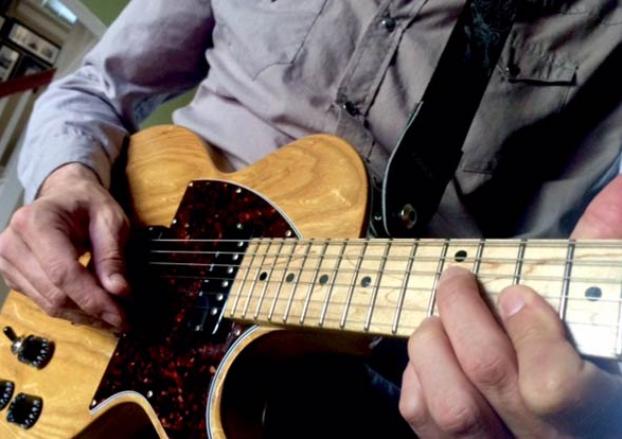Thinking Two Chords at a Time: Tritone Side-Stepping for Guitar
Bring a more modern sound into your jazz solos.

One of the most common questions I get from jazz guitarists of any experience level is, “How do I bring a more modern sound into my jazz solos?”
While there's no single answer, there are some things we can do in order to inject a bit of modern jazz flavor into our lines.
The first modern-jazz concept I like to explore with students who are new to this type of playing is to think and play two chords at once over a single harmony.
This means that if you see a G7 on a lead sheet for a tune you are playing, you are thinking about playing G7 and Db7 over that chord, as in the example below. There are a number of ways to do this, thinking of two chords at once, but one of the most popular uses two chords that are a tritone apart, such as the G7 and Db7 in this example.

Notice how the G7 arpeggio lays out all the “inside” notes, R-3-5-b7, while the Db7 arpeggio, when played over the G7 chord, sounds the b5-b7-b9 “outside” notes. So, when exploring this idea (of playing G7 and Db7 over a G7 chord), you can create tension with the Db7 arpeggio and release that tension with the G7 arpeggio.
With that bit of knowledge under our belts, let’s look at how this idea would sit on the neck and then take a look at a sample lick that uses this idea over a ii V I chord progression.
Side-Stepping Arpeggios
Now that you know you can use two arpeggios a tritone apart in your solos to bring a sense of tension and release to your lines, let’s explore these two arpeggios from a technical perspective on the neck of the guitar. You can take this concept to any 7th-chord arpeggio you know, mixing one fingering for G7 and one fingering for Db7 in each octave. But here's one I like to use because it covers a large amount of real estate on the neck and sits well under the fingers at the same time.
Try working on this fingering at a variety of tempos and in as many keys as you can across the neck of the guitar. When you can do that comfortably, try coming up with one- and two-octave fingerings of your own that you can use when playing two arpeggios a tritone apart on the neck.

Side-Stepping Lick Example
To help you get started with the tritone side-stepping concept, here's a ii-V-I lick that uses this concept to outline the G7 in bar 2 of the phrase. Notice how I used a melodic pattern to outline both of the tritone chords, G7 and Db7, which helps tie them together.
When applying “outside” concepts such as this, it often is helpful to use a pattern over one chord that repeats when you play the outside chord in order to keep them connected in a melodic fashion. Try learning this lick in C, then take it to all 12 keys around the neck.
When you can do that, write out three to five of your own ii-V-I licks using the tritone side-stepping concept over the V7 chord in each phrase. When you’re ready, you also can begin to insert this concept on the fly when soloing over tunes, but it’s best to start with a few licks first to get the sound of the two chords in your ears before you dive into this idea in a real-time solo.

How to Practice Tritone Side-Stepping
Once you have worked out the examples above, you can take these ideas further in the practice room in order to ensure you have a well-rounded learning experience as you explore thinking two chords over one in your jazz guitar solos.
Here are some of my favorite practicing ideas to help you get started.
1. Sing the root of a chord and then play the root and tritone arpeggios over that root.
2. Play a 7th chord on the guitar and then sing the root and tritone arpeggio over the chord.
3. Put on a jazz blues chord progression and use the tritone approach over the I7, IV7 and V7 chords in that blues to hear how it sounds in a blues tune.
4. Solo over a jazz standard and every time a 7th chord comes up, use the tritone concept to hear how it sounds in a jazz standard situation.
5. Write out a single-note solo over your favorite tune, then memorize it as you would any technical study, using the tritone approach over as many 7th chords as you can in the progression.
Do you have a question or comment about this approach? Post it in the COMMENTS section below!
Matt Warnock is the owner of mattwarnockguitar.com, a free website that provides hundreds of lessons and resources designed to help guitarists of all experience levels meet their practice and performance goals. Matt lives in the UK, where he is a senior lecturer at the Leeds College of Music and an examiner for the London College of Music (Registry of Guitar Tutors).
Get The Pick Newsletter
All the latest guitar news, interviews, lessons, reviews, deals and more, direct to your inbox!
Matt Warnock is the owner of mattwarnockguitar.com, a free website that provides hundreds of lessons and resources designed to help guitarists of all experience levels meet their practice and performance goals. Matt lives in the UK, where he teaches Skype guitar students all over the world, and is an examiner for the London College of Music (Registry of Guitar Tutors).









![Joe Bonamassa [left] wears a deep blue suit and polka-dotted shirt and plays his green refin Strat; the late Irish blues legend Rory Gallagher [right] screams and inflicts some punishment on his heavily worn number one Stratocaster.](https://cdn.mos.cms.futurecdn.net/cw28h7UBcTVfTLs7p7eiLe.jpg)
